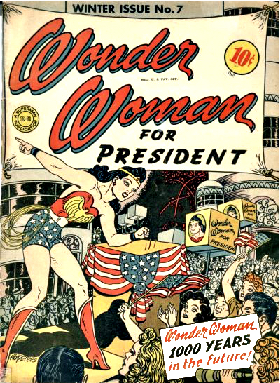Mike Gold: The All-Star Secretary
 Here’s what gets me about Wonder Woman.
Here’s what gets me about Wonder Woman.
She is, rightfully, symbolic of strong women who can take care of themselves, stand up for themselves, and help others – men and women alike – do the same. These are very good things. She started out before America entered World War II, so you can’t really attribute “Rosie the Riveter” juju to her origins: she was created at a time when most strong women were to be found in movies, and by then almost always in front of the camera and not behind it.
To be sure, there were plenty of other women super-heroes in comics. Some were spin-offs or sidekicks to male superheroes – Mary Marvel, Bulletgirl and the original Hawkgirl come to mind – but others were stand-alone creations: the original Black Widow (1940), Phantom Lady (1941), the original Black Cat (1942), Liberty Belle (1943), and my personal favorite, Miss Fury (1941), the only one of the bunch that was created, written and drawn by an actual woman. Wonder Woman thrived and was the principle reason DC Comics bought All-American Publications for the simplest and best of reasons: she was the most fully realized of them all.
But in lesser hands than those of her creators, she encountered her own glass ceiling.
Wonder Woman got her start in All-Star Comics #8, December 1941, as a nine-page feature backing up the usual Justice Society of America story. It was a bonus for the readers, as pages were added to the issue for the story. No mention was made of any of this on the cover. One month later, her series debuted in Sensation Comics #1 and she was so popular she was awarded her own title several months later.
She would return to All-Star Comics in 1942 when the Justice Society guys voted her in as their first female member, something long denied to Hawkgirl or Liberty Belle or even Merry, Girl of 1,000 Gimmicks (don’t ask). This was only a few months after the publication of Wonder Woman #1, and only 10 months after her debut appearance in All-Star.
Talk about the fast track. But, sadly, it was the fast track to that glass ceiling.
Wonder Woman joined the Justice Society not as a full-fledged member, but… wait for it… as the Society’s secretary.
No shit. While the readers’ moms were working at the defense plant, the phenomenally popular super-heroine was relegated to taking notes about the adventures enjoyed by the men. In fact, just like Rosie the Riveter her position was only guaranteed “for the duration of the war.”
Whereas she occasionally played an enhanced role in the story, Wonder Woman did not become a fully active member of the team until All-Star Comics #38, December 1947, six years after her debut in the same title. Coincidently, that story also offered a guest-shot from Black Canary, who was asked to deliver a message (“everybody else in the JSA is dead”) to Wonder Woman. In turn, WW picked up the bodies of her fellow JSA members – her fellow JSA fellows – and brought them back to life using the Amazon’s Purple Ray, a staple in the Wonder Woman series.
Amusingly, it was Black Canary who saved the JSA members at the end of the story. As a reward… no, she wasn’t made the new secretary… she was given the team’s thanks and a nice pat on the back and was made an honorary member. Three issues later, Black Canary finally was given full membership.
When the Justice League of America debuted in 1960, Wonder Woman was there as a fully involved member of the team. I’d say this represented progress, and I guess it did but those initial stories only had five fighting members of the team, Superman and Batman being “too busy” to join in the fun. That only left four other DC superheroes plus Wonder Woman. But there was no relegation to second-class status for the iconic heroine… and that does represent progress.
It would be a while until women were regularly involved in creating Wonder Woman’s stories, not to mention those of the other DC superheroes which were expanding like amoebas. But, hey, Eisenhower was president. The New Frontier didn’t start until the following year.











